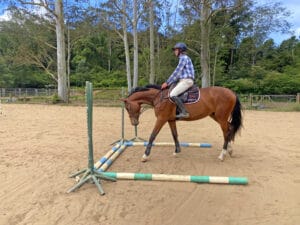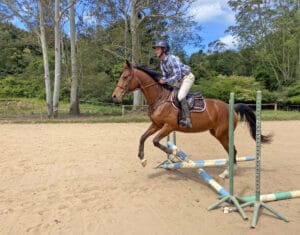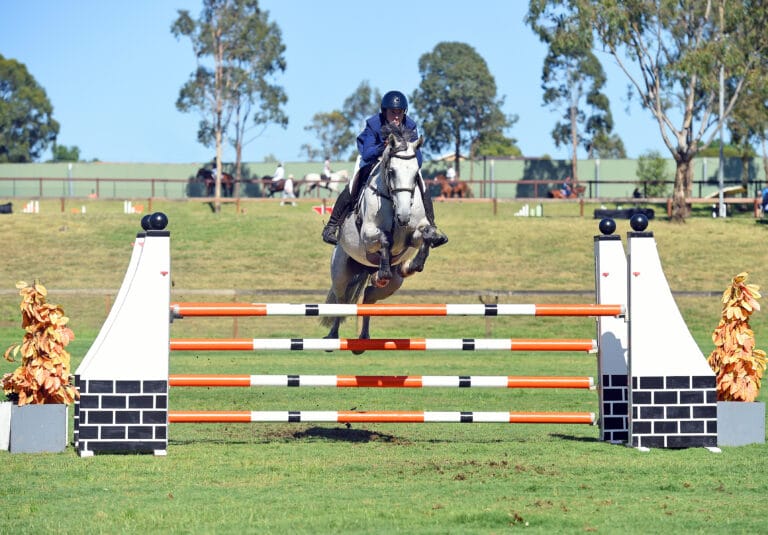While we were in lockdown last year, we looked at jumping on the lunge. Now with those days hopefully behind us, CHARLIE BRISTER dives into Part One of his two part series on teaching young horses to jump.
None of us liked lockdowns. But they did give a lot of people a lot more time to spend with their horses. Let’s hope you’ve been using your time wisely!
Looking back at our January/February 2021 issue, we finished our series on lunging by talking about jumping on the lunge. This is a really beneficial step when teaching your young horse to jump. Or, if you have an older horse who’s new to jumping, or a horse having problems with jumping, then you should go back to that step.
Jumping on the lunge: a brief recap
- Set up for success – think about how to make it as easy as possible for the horse.
- Start small and be progressive.
- When a horse stops at a jump it means they have either been over-faced (presented with a jump that’s too big for their level of training), or you gave them a less than ideal preparation before the jump.
- Introduce tarps or fill under the jump.
- And remember, if you do get stuck, there’s always another day.
Flatwork before jumping
The individual show jumping gold medal winner at the Tokyo Olympics, Ben Maher is a big believer in the importance of flatwork. He points out that show jumping is just flatwork with a few jumps in the middle. This highlights the importance of getting your horse calm, forward, and straight before expecting them to navigate a course of obstacles.
Having the basics of go, stop, and turn established (especially the go button) are pretty important unless you want to leave everything up to chance. With most horses, the first time you ask them to jump under saddle they’ll be a bit hesitant. Having a good response to your leg will help the horse to understand the question and gain confidence by getting over the jump with less confusion. While working on the lunge you should have been using your voice when asking for up and down transitions. It will help if your horse understands the voice cue for ‘go’ when you are riding.
Here’s one exercise on the flat that’s really good for preparing a horse to jump (see diagram):
- Begin by cantering down the long side of the arena.
- Come back to trot before the end of the arena.
- Ride half a 10 metre circle.
- As you come out of the half circle trot back to the long side you were just on, putting your new inside leg on to push them across to the long side. This will help prepare them for cantering away when you reach the long side at point ‘X’.
- Repeat on the other rein.

In this exercise, essentially a figure eight with one flat side, you have all the main components needed to navigate a course of jumps: transitions, straight lines, and half circles.
Moving on
If you’ve been lunging your horse over a set up similar to the one I suggested in the Jan/Feb 2021 issue, you will have made things much easier for yourself. Having two parallel guide rails on the approach to a jump will help keep your horse straighter and more focused on the jump ahead. You definitely want a coach/friend/pole person helping here. Start in walk with the guide rails and a single pole on the ground between the jump wings. When riding between jump wings, make sure there are no empty jump cups that your horse might catch a leg on if they drift.

You want the horse to be able to walk, trot and canter over the pole on each rein. With each step make sure the horse feels confident before increasing the difficulty. Over-facing them will make jumping much harder in the long run.

Next step is to build a cross rail. Once you have a jump in front of you there’s no need to walk in. Come in at a slightly forward trot, because using a little bit of momentum in the beginning can be helpful. As you get closer to the jump squeeze with your leg and maybe cluck if you feel a little hesitation. Before going to the whip, use a little patience – the whip should be the last resort to encourage the forward button. Usually the horse is hesitating because they are unsure or a little nervous. Give them time and reassure them.
What about your position?
Weight down into your heel is very, very important. A lower leg that is unstable will allow you to become unbalanced more easily. When trotting into fences try and maintain rising trot positioning. As the horse takes off for the cross rail, fold forward enough to hold the mane. Keep your upper body tilted slightly forward with your lower leg underneath you. Wait till the horse has fully landed before you sit upright in the saddle again. A common mistake is for riders to start leaning back as the horse finishes the jump. Stay in balance with the horse and avoid throwing your body around.
Cantering on
Now you’ve mastered trotting over the cross rail with ease, let’s talk about approaching in canter. On a young horse the canter is usually not that adjustable. Having a little adjustability is desirable but not essential. What is essential is the horse being able to maintain its line and tempo (direction and speed) without constant management. If your horse runs off in the canter or drifts all over the place then jumping is not the solution.
So assuming you can easily canter around the arena without too much trouble you can now approach the jump. Make sure it’s set in a location where it’s easy to turn towards it so you have a long run up. Try and sit quietly with your body and don’t fiddle on the reins with your hands (easier said than done!). Keep your eyes up and leg on as you take off, and don’t hesitate to grab a handful of mane to help stabilise yourself in the saddle.
What happens if you knock a rail down? No stress, just yell “ball boy” at your pole person. If they have watched tennis on TV, they will understand the need to put the pole back without wasting time!
It’s not uncommon for a horse to over-jump the fence in the beginning. This happens when they are being careful or spooky and don’t want to hit the jump, so don’t confuse it with confidence. Make sure that if they do it once fantastically you repeat it a couple of times on each rein before raising the height. It’s easy to get excited when your young horse feels amazing and you want to see what they can do.

Departing after the fence
Young horses may be a little wobbly on landing. Try and ride them as straight as possible after the fence. You want them to depart on a line and tempo similar to the way they approached. If they deviate from this, just do the opposite of what they’re doing wrong. For example, if they rush off after the fence, slow them down. If they veer right after the jump, turn them left and vice versa. You get the idea. Don’t punish the horse for doing the wrong thing but calmly educate them so they understand what the right thing is.
Next issue, we’ll talk about how to progress from jumping a single fence into preparation for jumping courses. Just remember: keep it simple and be progressive. Unfortunately, it may be simple, but it’s not always easy.



